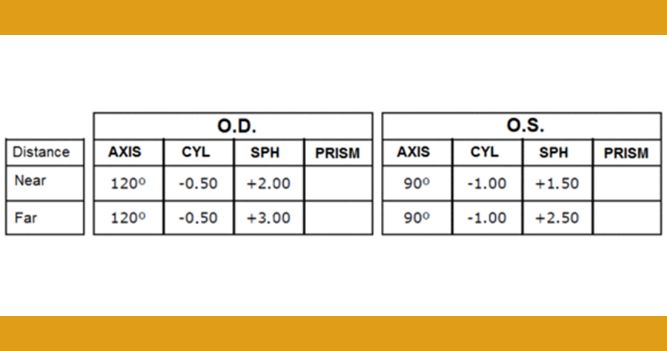You must have come across abbreviations such as OD, OS, RE, LE, SPH, and CYL, whenever you had an eye examination.
These abbreviations are written by the ophthalmologist on the eyeglass prescription and are also mentioned on the prescription glasses when you buy premium or luxury spectacles online.
But have you ever tried to interpret the readings or wondered what these abbreviations in your eyeglass prescription mean? If not, then this blog will help you understand the terminologies specified in the order.
So that next time you meet an optician, you can discuss comfortably and expertly with them. Without extending further, let’s understand the abbreviations.

OD, OS, and OU:
The first abbreviations you might come across are OD, OS, and OU. These are the Latin abbreviations; OS is an acronym for Oculus sinister which means ‘the left eye’ and OD is an acronym for Oculus dextrus which means ‘the right eye’ and sometimes, you might also see OU which is an acronym for ‘Oculus torque involving ‘both eyes.’
If you carefully observe your prescription, you will notice that OD comes first and OS second; this is because an ophthalmologist checks the right eye first and then the left eye second, when they come face to face with you for a checkup.
They note down the information in this order, right eye first and left eye second. These Latin abbreviations are generally used in traditional prescriptions.
But now, most eye clinics and ophthalmologists use modernized terminologies for a better understanding of the patient. Instead of OD, they use RE (right eye) and LE (left eye) for OS.
SPH (Sphere)
The ‘S’ refers to the Sphere, which specifies the power of the lens required to correct your vision, and it is measured in diopters (D).
The power ranges from -20.0 D to +20.00 D. If the number has a minus sign (–), it means you are myopic (nearsightedness), and if it has a plus sign (+), then it means you are hypermetropic (farsightedness).
Note: The range for myopic patients is from – 0.05 to -20.00 and +0.05 to +20.00 for hypermetropic patients.
CYL and Axis for Astigmatism:
CYL (Cylinder):
The ‘C’ refers to the Cylinder, which specifies the power of the lens required to correct astigmatism, and it is measured in diopters (D).
The power ranges from -20.0 to +20.00. An abnormality causes astigmatism in the shape of the cornea, instead of having a normal spherical curvature, the eye has an irregular curve.
The light rays do not meet at a common focus due to this irregular curvature and result in blurred, unclear, and distorted image formation. The more considerable the value of the Cylinder, the more astigmatism you have!
Axis:
After understanding the variance in curvature for astigmatism, the Axis specifies the orientation of the corrective lens (Cylinder). The number ranges from 0° to 180°.
DV, NV, and ADD (Addition) for Presbyopia:
If a patient has presbyopia, which is an age-related eye problem, where a patient loses the elasticity of the eye lens and results in long-sightedness, in this case, the patient requires multifocal lenses (i.e., bifocals, trifocals, or progressive lenses).
Abbreviations like DV, NV, and ADD are written, which specify whether the correction is required for distance vision (DV) or near vision (NV).
If both columns are filled, then multifocal lenses are needed. ADD signifies the additional magnifying power required for the lower half of your multifocal lenses. It is indicated by the (+) sign and ranges from +0.75 D to +3.00 D. The Add value is the same for both eyes.
PD (Pupillary Distance):
Pupillary Distance (PD) denotes the position of the lenses over the eyes. And it also measures the distance (in mm) between your right and left eye pupils.
Monocular PD is the measurement from the nose to the middle of the eye. And Binocular PD from the center of one eye to the other. It ranges between 55mm and 67mm.
PRISM
PRISM corrects the alignment of vision for uneven eyes. With the crystal diopters, you can measure. The direction mentioned is Base-down (BD), Base up (BU), Base in (BI), and Base out (BO). Specifying the thickness of the base rotation of the prism and the extent of binocular vision needed.
Better to know how you can read your eyeglass prescription and make an informed decision while buying premium eyewear online.

